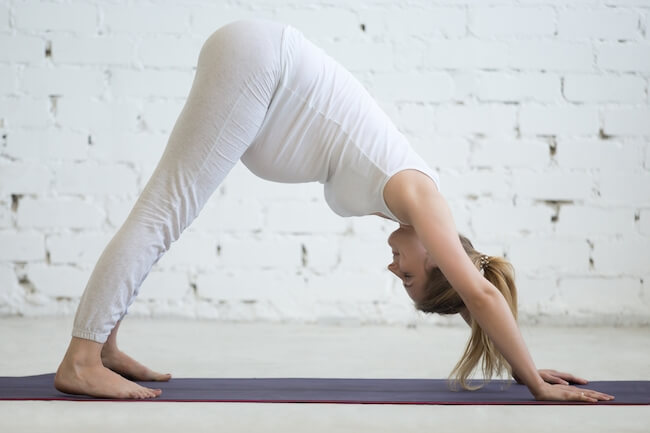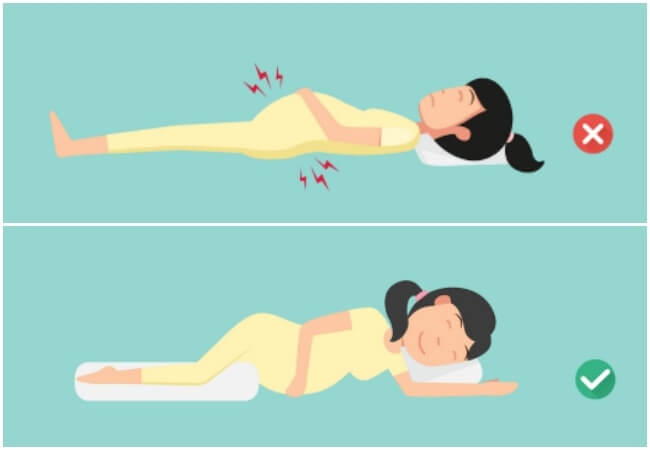Inside: Home exercises you can do during pregnancy that can help turn a posterior baby, so that your baby is in ideal birthing position.
When my midwife said those two dreaded words: “she’s posterior,” my heart sank.
With my first daughter, she was posterior and we ended up with a long, painful labor, and eventually an emergency c-section when she got stuck. (Read our birth story here).
This time around, I was determined to get my baby into anterior position, in hopes of a smoother labor. It was a lot of dedicated effort, but by the final weeks of pregnancy, my daughter was finally in the ideal anterior position for birth!
What is Posterior Position for Babies?
The OP position (occiput posterior fetal position) is when the back of baby’s head is against the mother’s back. You might also hear a baby in the OP position described as “sunny side up.” There are four posterior positions — Spinning Babies illustrates them here in an easy-to-understand way.
What is the Difference Between Posterior and Anterior Position?
Posterior babies are facing the same direction as you are, while anterior babies face your back.
Mama Natural explains why the goal is an anterior position for birth: “Anterior is the favored position because it encourages the baby to tuck their head and chin, creating the smallest head circumference as he/she passes through the birth canal.”
How a Posterior Baby Can Affect Your Pregnancy and Labor
- Back Labor — You may have heard from other moms about painful deliveries due to back labor. Since your baby’s head and spine are pressed against your own spine, it can indeed be quite painful. However, as someone who has experienced a both back labor and normal labor without an epidural or pain medication of any kind, I can tell you that they both hurt. I experienced less pain during active and transitional labor with my “normal” baby, but when I got to the pushing stage, I honestly couldn’t tell a difference in the pain level. It was extreme with both. Labor hurts, period, so don’t let the idea of back labor discourage you if you are not able to get your baby to turn.
- Prodromal Labor — With a posterior baby, you may experience days or even weeks of contractions leading up to your actual labor, but they come and go without progressing to active labor. Often called “false labor,” prodromal labor actually does help prepare your body for the “real” thing, and it may be your body trying to turn a posterior baby on its own. Prodromal labor can be exhausting and frustrating, but hang in there because your body is preparing itself, albeit slowly. Just make sure to get plenty of rest!
- Longer Labor — When a baby isn’t in the ideal birthing position, it may take longer to get them out. With my first daughter (posterior) I labored for over 20 hours. With my second (not posterior), I labored for less than half that time.
- Increased Chance of a C-Section — With my first baby, posterior position coupled with a shallow pelvis meant that I was unable to birth my daughter naturally. While a posterior baby does not automatically mean that you’ll need surgical intervention, it does raise the odds.
Related: 5 Things All C-Section Mamas Need to Hear
A posterior baby doesn’t mean that you’ll automatically end up with a c-section like I did, however, in some cases it can cause complications or a more difficult labor. In some cases it does not lead to any complications at all. And in many cases, a posterior baby will turn itself during labor.
However, if your baby is OP during your pregnancy, you may be able to turn them before you get to labor and avoid potential complications.
How Can You Tell if Your Baby is Posterior?
An easy way to know for sure if your baby is posterior is with an ultrasound. However, many doctors and midwives try to limit the number of ultrasounds during pregnancy, so they may use other methods to check position.
You might be able to tell by yourself if your baby is posterior. Since a posterior baby’s arms and legs are facing your tummy, you may feel their kicks more acutely. I had severe rib pain with my first baby (posterior) because she kicked them what seemed like all day, every day. With my second baby (anterior) I had no rib pain at all, and her movements felt more contained.
If your baby is anterior, you may be able to feel the solid mass of their back and/or butt against your stomach. With a posterior baby, your stomach might feel softer to the touch.
If you’re not sure, your doctor or midwife can confirm for you at your next appointment.
How to Turn a Posterior Baby Naturally
There ARE ways to turn a posterior baby naturally. I know because I did it!
These are the three main techniques I used to naturally turn my posterior baby to anterior:
1. Crawling
With my first pregnancy, my midwife instructed me to crawl for about 10-15 minutes a day, starting in my third trimester.
Yes, literally get down on my hands and knees and crawl on the floor. Crawling with a big ol’ baby belly is about as fun as it sounds, and I’ll admit that I didn’t do it as often as I should.
With my second pregnancy, my midwife had me start crawling much earlier, at 20 weeks or so. It seemed crazy to start so early, when my baby was only halfway grown, but I did it. I even enlisted my husband and older daughters to hold me accountable (and believe me, they did!)
How Crawling Helps Turn a Posterior Baby:
Crawling takes the weight of your baby off your back, and creates more space for the baby to turn. If nothing else, crawling is an excellent way to help relieve back pain and pressure!
2. Yoga
With my first pregnancy I practiced yoga at home, a few days a week for about 15-20 minutes at a time. Since I’d been through a miscarriage previously, I was scared to do any intense physical exercise, so I kept my workouts light.
When I picked yoga back up after my birth, I joined a local yoga studio with my husband. The sessions are an hour each and much more intense. Over the course of a couple years I built up a practice that I was proud of and felt like I was in the best shape maybe ever!
When I found out I was pregnant, I was determined to stick with my yoga practice at the studio. I’m convinced that my thrice-weekly yoga classes are responsible for a nearly pain-free pregnancy, as well as helping position my baby properly this time.
How Yoga Helps Turn a Posterior Baby:
Yoga in general helps to loosen up the body, so that you’re more relaxed. Stress and tension causes a lot of health problems overall, so it makes sense that it could be detrimental to pregnancy too. Yoga can help your overall well-being when you’re pregnant and I can’t recommend it enough.
Try These Positions:
- Downward-Facing Dog — When it comes to helping rotate a posterior baby, specifically the Downward-Facing Dog position is one to focus. This position can encourage the baby’s head to disengage from the pelvis, allowing it to move into a better position. (Note that when I say “disengage” from the pelvis, I don’t mean that your baby is going to get out of the “dropped” position, but rather get a little room to move into a better position for birth).
- Cat-Cow — This hands and knees position works like a combination of crawling and downward-facing dog. Alternating the motion of arching and scooping your back helps to move the baby out of the pelvis slightly so it can turn.
3. Side Sleeping
When you’re big and pregnant, it can be tempting to sleep in a recliner or propped up on pillows. This is mostly how I slept during the final trimester of my first pregnancy, but little did I know that it was likely keeping my baby from turning anterior!
During my second pregnancy, my midwife ordered me to sleep on my side at all times, with my bottom leg straight and top leg bent at a 90° angle (like you’re stepping over something). You can use a pregnancy pillow to support your top leg for more comfort. Sleeping on your left side encourages blood flow, but you can switch to your right when your left hip gets sore.
Related: Click here to see my picks for the best pregnancy pillow for side-sleeping.
How Side Sleeping Helps Turn a Posterior Baby:
I love the way Home4Birth describes the positive effect of side sleeping: “Sleeping on your side creates a ‘hammock’ for your belly and will encourage the baby to rotate.”
What To Do if Your Baby Won’t Turn
First, relax. Stress will only cause your body to tense up, which is the opposite of what you’re trying to accomplish. Keep trying your exercises right up until you give birth.
Second, know that your baby can still change position during labor. In fact, studies show that up to 90% of posterior babies will rotate to the anterior position during labor.
If you baby doesn’t turn, even during labor, you can still have a healthy birth. It might take longer, it might be slightly more painful…or it might not!
Finally, if you end up needing a c-section (as I did), remember that getting your baby into the world safely is what matters most…not how they got here. A surgical birth is not the easiest route, but I personally thankful for the medical advancements that prevent what might have otherwise resulted in injury or worse.
Disclaimer: This post is based on my own personal experience; your results may differ. Always consult with your health care provider before starting any new type of exercise during pregnancy.
More of our my most popular pregnancy posts:
What to Expect from a Home Birth
- Paper Chain Octopus Craft - April 24, 2024
- Amish Sugar Cookies - April 19, 2024
- Marshmallow Playdough - April 18, 2024








Leave a Reply